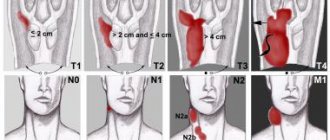Pharyngitis is an inflammatory process that forms on the back wall of the larynx and affects the mucous membrane, as well as deeper layers, tissues of the soft palate and lymph nodes. The acute form of pharyngitis can develop into chronic if the patient does not seek help from a doctor and self-medicates.
Since the pathological process in the larynx is caused by the spread of pathogenic bacteria, the risk of developing pharyngitis increases in people with a weak immune system and in those who suffer from ENT diseases or are predisposed to them.
How dangerous is pharyngitis and how does it manifest itself? Which doctor should I contact and how to treat the disease? We will answer these and other questions in this article.
Reasons for the development of pharyngitis
Experts believe that the peak development of pathology occurs at the end of winter and the beginning of spring, since at this time the human immune system is especially susceptible to colds. Often in the spring season, a lack of vitamins and microelements in the human body leads to the appearance of vitamin deficiency, the body weakens and creates an excellent environment for the development of pathogenic bacteria. Inflammatory processes are also possible: both separately and against the background of the underlying disease.
The first signs of pharyngitis and its further treatment may differ depending on the stage of the pathology, gender, age and general health of the patient.
We include the following as the main reasons for the development of pharyngolaryngitis:
- hypothermia, eating too cold foods;
- deformation of the nasal septum;
- strains of microorganisms that cause the development of chlamydia, candidiasis, whooping cough, scarlet fever, measles;
- adenovirus, influenza virus;
- streptococci, staphylococci, pneumococci;
- sinusitis, tonsillitis, caries, rhinitis;
- difficulty breathing through the nose;
- pathologies of the gastrointestinal tract: reflux, heartburn, hernia;
- abuse of bad habits;
- regular high loads on the vocal cords;
- polluted, toxic air;
- hormonal disorders and endocrine pathologies (diabetes mellitus, obesity, hypothyroidism, etc.);
- tonsillectomy, which was performed on the patient previously;
- infectious diseases in chronic form;
- weakened immunity.
Symptoms of pharyngitis
The first signs of the disease may differ depending on the type of pharyngitis. They are both local and general in nature. But there are common signs that are characteristic of any type of pharyngitis: sore throat, bad breath, stuffy ears and difficulty swallowing. With an active inflammatory process, an increase in body temperature above 38° can be observed - this is how the body fights a foreign infection. General signs: sweating, poor appetite, weakness, dizziness, fatigue, fever, chills. Some complain of pain and noise in the ears, and discomfort when exposed to loud sounds.
- During acute catarrhal pharyngitis, swelling and redness of the mucous membranes of the larynx appears. Also, red follicles may form on the back wall of the throat, and clear and slightly cloudy mucus may accumulate. There is swelling and redness of the tongue.
- In the purulent form of acute pharyngitis, ulcers with an accumulation of purulent masses appear on the surface of the posterior pharyngeal wall.
Precancerous diseases are a pathological process that determines the tissue’s readiness for malignant transformation. There are obligate and facultative precancerous diseases. Processes with a high degree of probability of developing malignancy are called obligate. Optional ones can undergo malignancy, but much less frequently.
Current state of the issue
Irina Shlyaga, head of the department of otorhinolaryngology with a course of ophthalmology at GomSMU, candidate of medical sciences. Sciences, Associate Professor. Among benign neoplasms, papillomas, fibromas, fibropapillomas, and dyskeratosis are more often subject to malignancy processes. Much less often, with the least degree of probability, tumor-like formations such as polyps, granulomas, cysts, and infiltrates. In many cases, the development of malignant processes in the larynx is preceded by benign diseases that last many months and sometimes years, which include chronic hyperplastic laryngitis (CHL).
Laryngeal papillomas are the most common formations among benign tumors. It is an exophytic epithelial tumor with a finely tuberous surface and slow growth. Occasionally, rapid growth of papillomas or diffuse damage to the laryngeal mucosa (papillomatosis) is observed, both in children and adults.
Dyskeratosis of the larynx is also often found and is a collective concept that includes several clinical forms: dyskeratosis proper, pachydermia, desquamative laryngitis, leukoplakia, keratosis, hyperkeratosis, leukokeratosis.
From a morphological point of view, it is a focus of pathological keratinization, and clinicians distinguish the above formations into separate ones, since they all differ in color, shape, size and have a favorite localization. They are often formed against the background of previously developed chronic hyperplastic laryngitis, which is a trigger for many benign neoplasms and malignant processes.
CGL , according to the WHO classification (2003) and according to our data (I.D. Shlyaga, P.A. Timoshenko, 1996, 2015), is classified as an obligate form of precancerous disease. Chronic laryngitis makes up about 65–70% of the pathology of the larynx, and among all pathologies of the ear, nose and throat - 10–15% (S. N. Kovalenko et al., 2009; I. D. Shlyaga et al., 2013).
The peak incidence is observed in able-bodied individuals, whose average age is 45±5 years. The ratio of men and women suffering from this disease is 3:1 (Bertini S., 2002). The structure of the incidence of chronic laryngitis among older people is also dominated by men (V.D. Osipov, 2006). The incidence of CGL in the population varies between 30–65%, and the probability of malignancy of this disease varies from 3% to 35%, reaching in some cases 60% in periods from 6 months to 7 years (F.I. Chumakov et al., 2002; V. D. Osipov, 2006; I. D. Shlyaga, 2009).
Malignant neoplasms belong to the group of the most socially significant diseases; in terms of mortality they are in second place after cardiovascular pathology. Malignant tumors of the larynx account, according to various authors, from 4% to 7% in the structure of oncological diseases and do not have a tendency to decrease.
Laryngeal cancer (LC) is the most common malignant neoplasm of the upper respiratory tract—it accounts for 40–60% (V.I. Chissov, 2005).
Laryngeal cancer.
According to the Belarusian Cancer Register 2022, the incidence of malignant neoplasms of the larynx in the republic is 1.4% (among the working population 2.2%). Due to the low detection of the disease in the early stages, the one-year mortality rate in the country was 22.2%, and the mortality rate from malignant diseases of the larynx in the Minsk region was 3.7 (3.3 for working age) per 100 thousand population (in Belarus - 3 and 2.1 respectively). When malignant neoplasms of the larynx are diagnosed in stages 1–2, the survival rate is 73–86%, and in stages 3–4 - only 15–33%.
Men, according to international statistics, are much more likely to develop malignant tumors of the larynx than women. In European countries, the incidence among men is 8.4 times higher than among women. This gender difference in Belarus is 48.4, in Russia - 17.4, Poland - 7.6, Lithuania - 16.8, Latvia - 18.5, Ukraine - 25.7. The highest incidence is recorded in the age groups 50–69 years in both the male and female populations.
Laryngeal cancer. The problem of timely diagnosis of malignant neoplasms of the larynx and the seriousness of the issue of quality of treatment for patients with this pathology is evidenced by the very high value of the mortality-to-morbidity ratio in many countries. In Latvia, the ratio of mortality to morbidity, according to GLOBOCAN 2022, is 47.1%, Poland - 54.5%, Russia - 55.2%, Belarus - 57.5%, Ukraine - 58.8%, Lithuania - 74, 2%. In Western European countries, this figure is significantly lower: in Germany - 41.1%, Finland - 34.4%, Sweden - 32.3%, England - 29.0%, France - 27.3%.
Laryngeal cancer. In addition, the relevance is determined by the high proportion of people of working age among the sick and the proportion of cases detected in the 3rd–4th stage. An analysis of the incidence of malignant neoplasms of the larynx in Belarus showed that in 2000–2019 there was an increase in incidence among the entire population (from 5.5 to 7.3 per 100 thousand) with a slight increase in the incidence of people of working age (from 4.0 to 4.3 per 100 thousand).
In all regions of the republic, an increase in morbidity rates by 1.2–1.3 times was noted, and among the working-age population by 1.1–1.4 times (p<0.05). On average in the republic, the incidence of malignant neoplasms of the larynx among urban residents increased from 4.8 per 100 thousand population in 2000–2004 to 5.9 in 2015–2019 (growth rate +22.9%), among the rural population - from 7 .9 to 10.5 per 100 thousand (growth rate +32.9%).
In the Gomel Regional Clinical Hospital, from 2007 to 2022, a retrospective analysis of patients who were undergoing inpatient treatment and examination was carried out. It was found that among patients with newly diagnosed laryngeal cancer, only 34% had stage 1–2, 53% had stage 3, and 13% had stage 4.
Causes
Numerous epidemiological studies conducted in different countries of the world have shown that the main etiological factors for the development of RG are smoking, alcohol, exposure to carcinogens on the mucous membrane of the upper respiratory tract (working with chemicals and in conditions of gas pollution, dust), a state of chronic stress, as well as chronic processes of various origins, so-called obligate processes, such as CGL, single papillomas in adults, laryngeal papillomatosis, dyskeratosis, etc.
Infections (bacterial, fungal, viral) can also be common causes of the development of precancerous diseases and laryngeal cancer; external and internal injuries of the neck and larynx, including unsuccessful intubations. Increased vocal load is of great importance. For urban residents, an unfavorable environmental situation plays a significant role - constant dust, gas pollution, pollution of streets and premises.
Of all the fungal infections of the upper respiratory tract, laryngeal mycoses are the least studied. Most authors consider laryngomycosis to be an extremely rare disease, however, according to our data, mycotic lesions of the larynx are a common disease, detected in 25–27% of all chronic inflammatory diseases of the larynx (I. D. Shlyaga, D. D. Redko, 2014).
The main causative agents of fungal infections of the larynx are yeast-like fungi of the genus Candida (90–95%), which includes 20 species. In patients with laryngomycosis, C. albicans, C. tropicalis, and C. krusei are more common. Less commonly, in 5–7% of cases, laryngeal mycoses caused by fungi Aspergillus, Penicillium, Mucor, Alternaria, etc. are observed. In some cases, damage to the larynx is caused by two or more pathogens. Various chronic forms of laryngomycosis (catarrhal-membranous, hyperplastic, infiltrative, atrophic, as well as often recurrent fungal-bacterial forms) can be prerequisites for the occurrence of tumor diseases of the larynx.
Recently, some researchers have given priority to the viral component in the issue of laryngeal carcinogenesis. This is due to frequent infection of the laryngeal mucosa by the human papillomavirus (HPV) in both benign and malignant processes. Thus, the frequency of detection of HPV in benign and precancerous neoplasms of the head and neck region varies from 18.5% to 35.9% (McKaig R. et al., 1998). The share of HPV-associated papillomatosis of the larynx, according to some authors, accounts for 40–100%, with subsequent malignancy in 8–20% of cases within 10 years (A.I. Paches, 2000, 2004; Szydlows WJ et al. , 1999).
Features of clinical manifestations
Precancerous diseases are characterized by:
- hoarseness, hoarseness (of varying degrees of severity), up to aphonia, which leads to difficulty in verbal communication;
- rapid voice fatigue;
- frequent relapses;
- duration of the course;
- insignificant effect from conservative treatment.
Laryngeal papillomas. Patients may experience discomfort, a feeling of a lump in the throat, spontaneous pain in the larynx (in advanced stages), shortness of breath (if the process is localized in the vocal folds, subglottic space), cough (less often). Some patients report a sensation of a foreign body, soreness, burning, tingling in the larynx, and occasional itching.
In some cases, precancerous diseases are asymptomatic, which depends primarily on the location of the process.
Dyskeratoses of the larynx. The clinical diagnosis of precancerous diseases and RG, even with the classic picture of their manifestations, must be confirmed by the results of a morphological study. In practical work, when establishing a diagnosis, it is necessary to differentiate CGL from a malignant process of the larynx and a number of precancerous diseases and pathological conditions. These circumstances dictate the need to use additional research methods during dynamic monitoring of this category of patients.
Diagnostics
Early diagnosis of a malignant process is one of the most complex and as yet unsolved problems throughout the world; it presents certain difficulties due to the lack of specific symptoms, the long-term satisfactory condition of patients, the presence of concomitant inflammatory and dysplastic processes that mask the underlying disease, and the variety of clinical manifestations as precancerous ones. , and tumor diseases of the larynx, the difficulty of examining the larynx, insufficient qualifications of doctors, and the lack of oncological alertness among many clinicians.
The presence of many methods for diagnosing diseases of the larynx (direct and indirect laryngoscopy, electronic stroboscopy, fibrolaryngoscopy, radiation diagnostic methods, cyto-, histological and immunohistochemical studies, etc.) often puts laryngologists in a difficult position regarding the choice of the optimal method, especially since many of them are recommended as the most effective. Most otorhinolaryngologists are of the opinion that histological examination of the material obtained from a biopsy is the main method of confirming the clinical diagnosis.
However, in some cases, with an obvious clinical picture of a malignant process of the larynx, the results of a histological examination of the material obtained from an intralaryngeal biopsy, including a repeat one, may be negative, since the tumor is often localized in places difficult to access for biopsy and it is necessary to give an opinion on very small pieces of tissue, or it is not possible to take material from the lesion. It is especially difficult to obtain material during endophytic growth of a malignant tumor.
The use of other modern diagnostic methods (CT, MRI) provides significant additional information about the localization and extent of the process. However, based on these methods, it is impossible to judge the nature of the disease, especially in cases where there is a suspicion of malignancy of long-existing dysplastic processes.
This is possible, in particular, in cases of the formation of a large area of perifocal edema and tissue inflammation around the tumor, which makes it possible to differentiate the onset of the malignant process and the proliferation of inflammatory epithelium.
Treatment approaches
Treatment of patients with precancerous diseases of the larynx, including CGL, should be individualized, taking into account oncological alertness, localization and extent of the process.
The principles of treatment of precancerous diseases of the larynx are as follows: the main condition is the exclusion of harmful etiological (cessation of smoking, alcohol) and occupational factors; compliance with voice mode; rehabilitation of foci of chronic infection (chronic rhinitis, sinusitis, tonsillitis, pharyngitis, tracheobronchitis).
It is very important to eliminate the curvature of the nasal septum in order to restore full physiological breathing through the nose. Patients in this category undergo both conservative treatment (general and local) and surgical treatment, depending on the localization and extent of the process, data from microbiological and morphological studies.
Conclusion
Thus, this problem is relevant in social and economic terms due to the high level of disability of patients with GC (about 65%), and most importantly - in demographic terms (one-year mortality in Belarus is 22%, and the survival rate of patients with diseases is 3 -4th stage - 15–33%).
The increase in the incidence of laryngeal tumors observed over the past 20 years dictates the need to develop measures to improve medical care for patients with this pathology. The above statistics indicate the need to take urgent measures to organize the timely detection of laryngeal tumors.
In order to draw attention to the problems of early diagnosis of this cancer, the European Head and Neck Society (EHNS) initiated the annual European Head and Neck Cancer Early Diagnosis Week in the third week of September. This initiative has been carried out in Belarus since 2014. Its main goal is to increase awareness of the population and medical workers about head and neck cancer, measures for its prevention, diagnosis and treatment. Patients have the opportunity to learn about tumor prevention measures, symptoms of diseases, and also understand the importance of early consultation with a doctor. All practicing doctors should have high oncological and mycological alertness.
To make a correct diagnosis, it is necessary to conduct a comprehensive examination of patients with the involvement of related specialists: GPs, therapists, infectious disease specialists, mycologists, endocrinologists, microbiologists, morphologists, oncologists, etc.
It is also mandatory to use instrumental and laboratory research methods, with a morphological examination of suspicious areas. If the clinical picture corresponds to RG, but it is not confirmed morphologically, further examination and repeated biopsies (more radical, from different areas under endotracheal anesthesia) are necessary.
A timely diagnosis not only contributes to the effectiveness of treatment and the preservation of various functions of the larynx (vocal, respiratory and protective), but most importantly, it makes it possible to prevent the development of various irreversible consequences and complications, often leading to patient disability and death.
Acute pharyngitis
Acute pharyngitis can occur independently, and can also be accompanied by acute inflammation affecting the upper respiratory tract: rhinitis or inflammation of the mucous membranes of the nasopharynx.
Depending on the cause of development, acute pharyngitis occurs:
- Viral – most often caused by rhinovirus;
- Bacterial – caused by streptococci, staphylococci and pneumococci;
- Fungal – source of the inflammatory process – Candida;
- Traumatic - caused by damage to the pharynx and larynx: the throat was scratched by a sharp bone or burned by boiling water, severe stress on the ligaments;
- Allergic – occurs when inhaling allergens or irritants, such as tobacco, exhaust fumes or dusty air.
Chronic pharyngitis
According to the depth of damage to the pharyngeal mucosa, chronic pharyngitis is divided into: catarrhal, hypertrophic and atrophic forms.
- Chronic catarrhal pharyngitis - there is slight swelling of the tissue layers of the pharyngeal mucosa. Individual areas are sometimes covered with clear or slightly cloudy mucus. It develops as a result of acidic gastric contents entering the throat, for example, in the case of a hiatal hernia. Therefore, catarrhal chronic pharyngitis is a consequence of the development of diseases of the gastrointestinal tract.
- Chronic hypertrophic pharyngitis is a significant severity of swelling of the mucous membrane. Additionally, thickening of the uvula and swelling of the soft palate are observed.
- Chronic atrophic pharyngitis is characterized by some thinning of the lining of the pharynx. They are usually pale pink, sometimes shiny varnished. Some of their areas become covered with crusts, viscous mucus and pus.
Any type of chronic pharyngitis develops due to the fact that the acute form of the disease was not cured in time and developed into a more serious form. Chronic pharyngitis also appears as a consequence of rhinitis, sinusitis, deviated nasal septum, nasal polyps - that is, when nasal breathing is difficult for a long time. In addition, long-term use of vasoconstrictor drops also leads to the appearance of chronic pharyngitis.
Causes of laryngeal cancer
Malignant tumors form in tissues as a result of certain processes occurring in them; tissues change their structure, the same applies to organs. Among the most common causes of throat cancer
and negative factors provoking the disease can be identified as follows:
- long-term smoking,
- frequent consumption of alcoholic beverages,
- significant changes in tissues, the presence of benign formations - cysts, fibroids, untreated inflammation in the body,
- constant inhalation of harmful gases, acids, alkalis, gasoline and exhaust gases, as well as dusty air entering the lungs.
of laryngeal cancer are frequently reported
among people employed in hazardous industries, where they have to deal with various varnishes, paints, gases, oils, and gasoline vapors. Also dangerous are pulp and paper enterprises and organizations where there is interaction with asbestos. This can also include enterprises in the automotive industry, all places where there is welding.
throat cancer, what to do
The average portrait of a person with laryngeal cancer is a middle-aged man who works in hazardous work, smokes several cigarettes a day, and drinks often.
Smoking is objectively placed in first place among the factors that provoke the first signs of throat cancer
, there is information that more than 90% of patients are smokers with a solid history; the number of smokers with laryngeal cancer is approximately 20-30 times greater than the number of people without such a diagnosis.
Tobacco smoke is a source of various toxic substances, including radioactive ones, as well as soot. All this passes through the larynx, settling on the mucous membrane, provoking its inflammation, which becomes chronic. All this leads to the appearance of neoplasms. Smoking, according to statistics, leads to death from cancer in 30% of people who are faced with this disease, most often men. Filter cigarettes are not a panacea for oncology, because they retain a small proportion of harmful substances that affect the mucous membrane. Tobacco smoke is no less harmful for people nearby - they also have a risk of getting a tumor of the larynx
.
How does pharyngitis manifest and progress in children?
Children suffer from pharyngitis more severely than adults. This especially applies to babies under one year old. Swelling of the mucous membrane can cause signs of suffocation; the pain that accompanies the disease reduces the child’s appetite. Often, a baby’s body temperature can reach 40°. The most difficult thing in this situation is that a small child cannot say what hurts.
Incorrect treatment can lead to irreparable consequences for a small, fragile organism. Therefore, at the first signs of pharyngitis, consult a doctor immediately.
Sore throat and pharyngitis: what is the difference?
The general condition of the patient with acute tonsillitis or tonsillitis can be confused with the symptoms of pharyngitis. If the disease is diagnosed incorrectly, then treatment of pharyngitis in adults will not have any effect. And the acute form of the pathology can develop into a chronic one.
Unfortunately, many patients self-medicate and start using medications without a doctor’s specific prescription. This is extremely contraindicated! It is better to take care of your health in time and seek help from an experienced otolaryngologist.
It is important to remember that during pharyngitis, the larynx becomes inflamed, and during tonsillitis, the tonsils become inflamed. During a sore throat, it is always painful to swallow, and the pain intensifies even more when eating food. With pharyngitis, the opposite happens - while eating warm food or warm drinks, the sore throat decreases.
During the development of a sore throat, there is no cough or sore throat, only a sore throat and sometimes the formation of a white coating. With pharyngitis, there is a sore throat, as well as noise, pain, or congestion in the ears. The difficulty in distinguishing between these two diseases is further complicated by the fact that one patient can simultaneously develop both pathologies, since they are caused by the same pathogen.
Diagnostics – accuracy and efficiency
At Top Ikhilov, the diagnostic process is planned in advance, even before the patient arrives at the clinic. Typically the entire examination takes 3 to 4 days.
- Day 1
- Day 2
- Day 3
First day
Upon arrival at the clinic, the patient has a consultation with the attending physician. The specialist reviews the medical documentation brought by the patient, conducts an examination, finds out what the symptoms and general well-being of the patient are. At the final stage of the consultation, the doctor decides what additional studies may be required to verify the diagnosis.
Second day
On this day, the patient undergoes all diagnostic procedures prescribed by the doctor. It can be:
- CT or MRI scan;
- chest x-ray;
- laryngoscopy;
- PET scan;
- biopsy;
- laboratory tests of blood and urine.
The third day
After the results of the examination are known, a medical consultation will be held. Israeli specialists collectively review all the results, confirm the diagnosis, assess the prognosis and select the most appropriate treatment regimen for each specific case.
Diagnosis of pharyngitis
Detection of all types of pharyngitis begins with a visual examination of the larynx using a special device and taking an anamnesis. A throat swab is also taken for examination to test for diphtheria.
Other types of diagnostics:
- Cultural examination - inoculation of taken materials on a nutrient medium.
- Rapid diagnosis - identification of streptococcal antigen in throat swabs.
- Immunoserological diagnosis - the method is used in case of streptococcal infection.
Laboratory research:
- Complete blood count – exclusion of blood diseases, infectious mononucleosis;
- A general urine test helps rule out kidney disease (glomerulonephritis).
Depending on the symptoms of the disease, as well as the condition of the larynx, the presence or absence of cough, fever, plaque on the tonsils and soreness and increased size of the lymph nodes, additional consultations with other specialists may be necessary: an endocrinologist, a cardiologist, an allergist.
Diagnosis of cancer at stage III
To diagnose cancer at the third stage, the doctor carefully collects an anamnesis of the disease from the patient’s words, focusing primarily on his complaints.
Next, based on the history and physical examination (external examination and palpation), an examination plan is prescribed. The main points of this plan are the following examination methods:
- Indirect and Direct laryngoscopy (fibrolaryngoscopy). The latter allows you to examine all parts of the larynx with maximum clarity. Insertion of the instrument into the larynx does not cause any harm to the patient, allowing high-quality photography and video recording.
- During fibrolaryngoscopy, a biopsy of the tumor is performed and the resulting tissue samples are sent for histological (including immunohistochemical) and cytological studies to make a morphological diagnosis (to understand the structure of the tumor, the degree of its differentiation)
- Ultrasound of the neck and abdominal organs (to exclude or determine metastases, their location and size)
- Chest X-ray (to exclude metastases in the lungs)
Modern medicine makes it possible not only to diagnose the disease, but also to identify its features.
If the data received by the doctor is not enough to make a diagnosis or determine operability, then they resort to prescribing clarifying or additional diagnostic methods:
- computed tomography (CT) of the neck, chest organs
- magnetic resonance imaging (MRI) of the neck, chest organs, abdominal organs)
- Radioisotope study of skeletal bones
- determining the relationship between a tumor and the presence of HPV (HPV) infection (HPV – Human Papilloma Virus)
- molecular genetic diagnosis of tumor tissue (when planning targeted or immune therapy)
The above diagnostic methods are necessary for correct diagnosis and prescribing appropriate treatment.
Treatment methods for pharyngitis
Treatment must be comprehensive. The patient is prescribed medications that will relieve pain and reduce inflammation. It is also important to adhere to a special diet and exclude from the diet foods that irritate the mucous membrane of the throat and bring even more discomfort: alcoholic beverages, spicy and salty foods, sour foods, carbonated drinks.
Drug therapy
Depending on the clinical picture and general condition of the patient, the doctor may prescribe antihistamines, antitussives and antiviral medications. Lozenges/lozenges are used to relieve pain.
In some cases, they resort to the use of antibiotics. They can only be taken as directed by a doctor.
Local impact
Rinsing with special solutions also has a good effect on the inflammatory process and redness of the larynx. They have a gentle effect, relieve pain and improve the general condition of the patient.
To diagnose and identify the disease, you need to consult an otolaryngologist. At the city clinic, you can contact your primary care physician, who will issue a referral to an ENT specialist. However, this takes time. You often have to wait 2 weeks for an appointment with a doctor. In some cases, this is simply impossible, since it is necessary to quickly conduct an examination and prescribe treatment before the situation becomes critical.
Therefore, we recommend contacting the Medunion medical clinic. We employ practicing otolaryngologists, and you don’t have to wait several weeks for appointments. Sign up today for a time convenient for you, and get tested tomorrow.
Patients choose us because we provide the service of a specialist coming to your home if you cannot come to the clinic on your own. You can also take samples directly at home.
The cost of an initial consultation with an otolaryngologist in Krasnoyarsk at the Medunion clinic starts from 1,300 rubles. You can sign up on the website or by calling 201-03-03.
Treatment of stage III cancer
Among all patients with laryngeal cancer seeking help from medical institutions, patients with stage III constitute the largest and most diverse group in terms of prevalence. Therefore, these patients are the most difficult to diagnose and choose treatment tactics. That is why complex therapy (a combination of surgical, radiation and drug treatment) is most often used to fight cancer at the third stage. Only a timely start and the correct combination of all the above types of treatment, as a rule, allows one to achieve the maximum effect, i.e. cure for this disease.
Surgery
The most radical type of treatment for laryngeal cancer continues to be surgical (laryngectomy/resection of the larynx + cervical lymph node dissection). But most of all, this provision applies to the fold localization of the tumor process and with clear boundaries of the primary tumor. Further, provided that the operation is radically performed, the effect can be consolidated by radiation therapy. Currently existing voice prostheses, installed simultaneously with removal of the larynx, allow the patient to return to a decent quality of life without loss of voice in the shortest possible time (from 2 weeks after the day of surgery).
Chemotherapy
For infiltrative tumors and spread to the supraglottic region, it is considered most effective to begin treatment with chemotherapy (neoadjuvant) or combined chemoradiotherapy. The standard first-line regimen is TPF (taxanes, platinum drugs, 5-fluorouracil). One course takes 4-5 days in a hospital setting. The cycle is 21 days (this means that 3 weeks must pass from the first day of the first course of chemotherapy to the first day of the second course). After 2-3 courses, a control examination is prescribed, the effect is assessed and further tactics are determined by the consultation. With combined chemoradiotherapy, platinum drugs are administered weekly during radiation therapy. The polychemotherapy regimen, drug dosages and administration regimens are determined by the chemotherapist individually for each patient, based on his general condition, examination parameters, as well as the type and extent of the tumor.
In some cases, provided the tumor is highly sensitive (this is determined during treatment), a cure can occur without surgery.
Radiation therapy
Radiation therapy, like chemotherapy, is not used alone for stage III laryngeal cancer. In combination with chemotherapy, provided the tumor is highly sensitive, it is used in the form of a radical course (bringing the total focal dose to 65-70 Gy). Treatment is carried out 5 days a week at a dose of 2 Gy/day, respectively, lasting about seven working weeks. The radiologist determines the postoperative radiation therapy regimen individually, based on prognosis factors (determined based on histological examination of the surgical material).
Diet
The nutrition of a patient with laryngeal cancer should prevent the aggravation of the initial symptoms of the disease and the side effects of treatment, as well as exhaustion of the body. Food must be well thermally and mechanically processed so that it does not injure the pharynx and is quickly absorbed. The temperature of food before use should be close to room temperature. The products consumed are carefully crushed and taken in small portions 5-6 times a day. The volume of water consumed is at least 2 liters.
- slimy pureed soups cooked in low-fat meat broth;
- semi-viscous cereal porridge, boiled in water and half with milk;
- boiled fish dishes, chopped using a blender;
- vegetable purees from potatoes, carrots, pumpkin, beets and cabbage;
- freshly squeezed fruit and vegetable juices (exclude sour ones)
- fermented milk products, including yoghurt, kefir and fermented baked milk.
Be sure to take into account that food should not be fried, spicy, or contain spices and seasonings. You should also avoid coffee, strong tea and alcoholic beverages.









